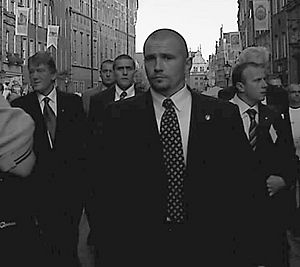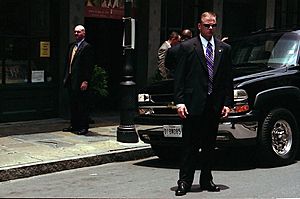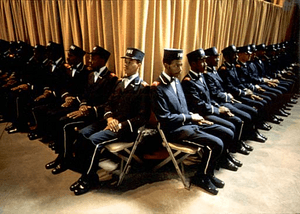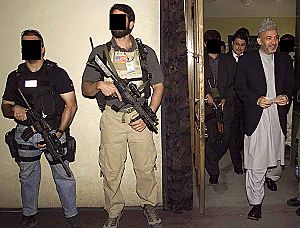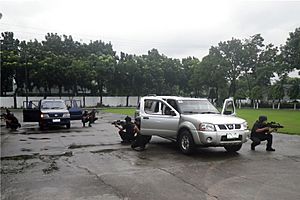Bodyguard facts for kids
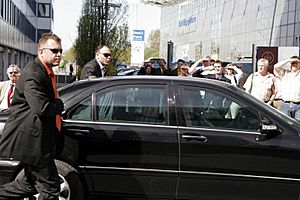
A bodyguard is a security guard whose job is to physically protect a person from harm or injury. Important people often have bodyguards. This includes leaders of countries, famous actors, and very rich people.
Contents
What Bodyguards Do
Bodyguards have many important jobs. Their main goal is to keep their client safe.
More Than Just Action Movies
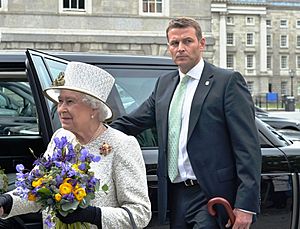
Movies often show bodyguards in exciting gunfights. But in real life, their job is usually much less dramatic. Real bodyguards spend most of their time planning and preparing.
Their daily tasks include:
- Planning safe routes for travel.
- Checking rooms and buildings before the client arrives.
- Learning about people who will meet the client.
- Searching vehicles for anything dangerous.
- Carefully escorting the client during their day.
Different Roles in a Team
The job of a bodyguard can change based on their team role.
- A driver-bodyguard drives the client safely.
- A close-protection officer stays very close to the client.
- Other team members might check for hidden bombs or electronic listening devices. They also check backgrounds of people.
The level of risk a client faces also changes the bodyguard's job. For example, protecting a leader from assassination is different from protecting a celebrity from photographers. Some bodyguards even specialize in protecting children of important people. This keeps them safe from kidnapping.
Driving Safely
Bodyguards often drive their clients. Usually, more than one bodyguard is needed. This is because the car cannot be left alone. If left alone, someone could hide a bomb or a listening device.
Drivers are trained in special driving skills. These include quick turns and high-speed cornering. The cars used are often large, strong sedans like Jaguars or Mercedes Benz. Sometimes, large trucks like Suburbans are used.
These special cars usually have:
- Bulletproof windows.
- Armor to protect against gunfire.
- "Run-flat tires" that can still drive when flat.
- A PA system to talk to others.
- Fire extinguishers.
- Strong bumpers to ram other vehicles if needed.
Sometimes, decoy cars are used. These cars trick anyone trying to follow the client.
Weapons and Safety Gear
Bodyguards may carry different types of weapons. This depends on the laws where they work. Some carry non-deadly weapons like pepper spray or a Taser. Others, especially government bodyguards, may carry handguns or even machine pistols. In very risky places, like war zones, they might carry assault rifles.

Bodyguard teams might also have sniper rifles for long-distance protection. They might also use shotguns.
Bodyguards protecting high-risk clients often wear body armor. This can be made of kevlar or ceramic. They might also use special shields, like briefcases that can stop bullets. The client might also wear body armor in very dangerous situations.
Protecting Against Snipers

To protect against sniper attacks, bodyguards focus on defense. They try to keep the client inside an armored vehicle or a safe building. When the client moves between a car and a building, they move very quickly. Other bodyguards walk close by to block any possible shots. It is very hard for bodyguards to fight back against a hidden sniper.
A Bodyguard's Day
A bodyguard team protecting an important politician has a busy day. They escort the client from a safe home to meetings and other activities. Then they bring the client back home.
Planning the Day
The day starts with a meeting led by the team leader. They review the client's schedule. They plan how to handle travel, escorting, and watching for threats. The client might travel by car, train, or plane. They might attend meetings, dinners, or personal events.
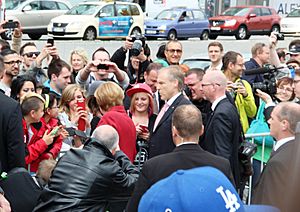
The level of risk changes throughout the day. Meeting people at an outdoor event is high risk. Dining at a secure club is low risk.
Some planning happens days before. Bodyguards might drive the routes to check for road work or detours. They also check the places the client will visit. They look for hidden bugs and check exits and entrances. They also learn the names of staff who will meet the client.
Bodyguards get special training. This includes:
- Firearms tactics.
- Unarmed combat.
- Tactical driving.
- First aid.
Some bodyguards specialize in tasks like crowd control or searching for explosives. They also learn how to assess risks and find security weaknesses.
Bodyguards learn to check a place before the client arrives. They find exits, entrances, and security weak spots. They also meet the staff to make sure no attacker is pretending to be a staff member. They research potential threats, like protests or dangerous people.
Many countries train their military members to be bodyguards for leaders. There are also private bodyguard training programs. These teach all parts of close protection, including legal rules for using force.
Checking Vehicles
About an hour before leaving, driver-bodyguards check the cars. For high-risk clients, there might be several cars in a convoy. They inspect each car carefully. Once checked, the cars are never left alone. This prevents anyone from putting a bomb or damaging the car.
Getting into the Car
When the cars are ready, they are parked close to the building's exit. The bodyguard team then surrounds the client. They move quickly from the safe building to the car.
Traveling Safely
The convoy then drives to the destination. The team chooses routes that avoid dangerous "choke points" like one-lane bridges. These spots are easy targets for an ambush. Traveling on foot is very risky because there is less protection.
Arriving at the Destination
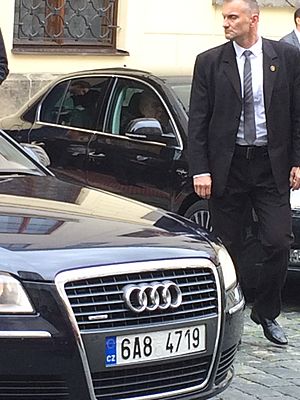
When the convoy arrives, some bodyguards get out first. They check that the area is safe. They also confirm that the right staff members are present. If it's safe, they signal for the client to come out. The client is then escorted into the building.
If the client is in a very secure building, they might not need bodyguards right next to them. The bodyguards can watch from a distance. They might monitor entrances and exits. The driver-bodyguard watches the cars.
The number of bodyguards around the client changes throughout the day. It depends on how risky the situation is.
Returning Home
After the day's activities, the client is brought back to their safe home. The walk from the car to the door is kept very short. Once the client is inside, bodyguards assigned to overnight duty take their positions. The cars are parked in a locked garage to keep them safe. The team leader makes sure all equipment is ready for the next day.
Images for kids
-
U.S. Secret Service agents guarding U.S. President Barack Obama
-
Quanell X (center), the leader of the New Black Panther Party, with his bodyguards.
-
A Croatian close protection unit training with sub-machine guns and pistols.
-
An 18th-century Manchu Imperial Guard of the Qianlong Emperor.
-
The Cossacks Imperator Bodyguard unit from the early 1900s.
See also
 In Spanish: Guardaespaldas para niños
In Spanish: Guardaespaldas para niños


